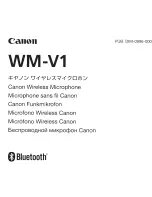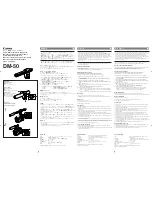
Issue 1
1
947189
MULTI-ZONE MICROPHONE
V-5335405
by
PagePac
®
INTRODUCTION
Your high fidelity desk microphone provides high
quality, low noise single and multi-zone paging
capability to existing paging products. A cardioid
electret element suppresses background noise,
and is housed on the end of a flexible tube. You
can page through a momentary push-button for
short pages, or make a long page with a lock-on
button. Front panel LEDs indicate paging status
(see Figure 1).
The back panel is shown in Figure 2. An attached
wall socket transformer provides power to the unit.
Connections for tip and ring, busy buss, and dry
contact closure are made at a compression screw
terminal block. You can adjust the output volume
level by screwdriver. The multi-zone model has a
switch for selecting dedicated single zone paging.
SPECIFICATIONS
FEATURES
• DTMF Pad for Multi-Zone Access
• Can be Switched to Dedicated Single-Zone
• Momentary Push or Lock-On Page Button
• Front Panel LEDs
Power Requirements
• 120 VAC, 60 Hz
Dimensions/Weight
• Base: 7”W x 3”H x 5”D
(17.78cm x 7.62cm x 12.7cm)
Gooseneck: 14”H (35.56cm)
• 2.50 lbs (1.13 kg)
OPERATION
To make a short page, press and hold the larger,
momentary contact push-button. To make a longer
page, press the smaller locking push-button; when
the page is over, press this push-button again to
deactivate. On the multi-zone model, use the
DTMF pad to select zone addresses or implement
paging features; Refer to your Page Controller
Manual for zone options.
The three LEDs on the front panel show paging
status. A flashing yellow LED indicates a long
term page. The red LED indicates a busy condi-
tion on the system. The green LED indicates that
the microphone is on and ready to initiate a page
(even when the unit is paging).
The volume can be adjusted by using the screw-
driver-accessible output level at the back panel
(see Figure 2).
INSTALLATION
The microphone has rubber feet for placing
directly on a desktop. Connect the transformer to
a standard 120 VAC 60 Hz wall socket. Figure 3
shows the wiring connections at the microphone
terminal block. Multiple microphones may be
wired to an amplifier in either a star or daisy chain
configuration, as shown in Figure 4. Choose the
configuration that minimizes the length of wiring
runs.
Figure 5 shows the wiring diagram for connecting
microphones to a PagePac D-Series AmpliCenter
amplifier. An additional terminal block is recom-
mended with the star configuration for connecting
the various incoming wires at the amplifier end.






















